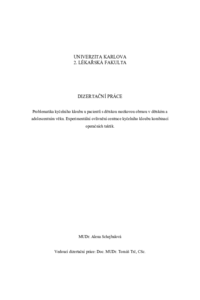Problematika kyčelního kloubu u pacientů s dětskou mozkovou obrnou v dětském a adolescentním věku: experimentální ovlivnění centrace kyčelního kloubu kombinací operačních taktik
Problems of the hip in patients with childhood cerebral palsy in childhood and adolescence. Experimentally influenced centering of the hip by a combination of operational tactics
dizertační práce (OBHÁJENO)

Zobrazit/
Trvalý odkaz
http://hdl.handle.net/20.500.11956/3023Identifikátory
SIS: 140026
Katalog UK: 990005850060106986
Kolekce
- Kvalifikační práce [1802]
Autor
Vedoucí práce
Oponent práce
Koudela, Karel
Karpaš, Karel
Kokavec, Milan
Fakulta / součást
2. lékařská fakulta
Obor
EXPERIMENTALNI CHIRURGIE
Katedra / ústav / klinika
Klinika dětské a dospělé ortopedie a traumatologie
Datum obhajoby
13. 4. 2006
Nakladatel
Univerzita Karlova, 2. lékařská fakultaJazyk
Čeština
Známka
Prospěl/a
Vývoj kyčelního kloubu probíhá po celé období růstu dítěte, dochází ke změnám nejen oblasti horního konce femuru ve smyslu změn kolodiafyzárního úhlu a úhlu anteverze, které se postupně s růstem dítěte zmenšují až do dospělosti, ale i změnám orientace jamky. Výsledný tvar je dán součinností svalové rovnováhy, která současně ovlivňuje i výslednou délku krčku femuru a velikost velkého trochanteru - tedy artikulotrochanterickou distanci. U dítěte s DMO je geometrie kyčelního kloubu po narození fyziologická, pokud není kombinace s vrozenou DDH. Spastické adduktory a mediální ischiokrurální flexory negativně ovlivňují vývoj kyčelního kloubu během růstu dítěte. Brání postupnému fyziologickému zmenšování kolodiafyzárního úhlu a úhlu anteverze proximálního femuru, a tím vzniká coxa valga antetorta neurogenes postupně s event. subluxací až luxací. Při subluxaci až marginální luxaci se uplatňuje spastický m. iliopsoas, který je v této fázi hlavním luxačním svalem. Primární insuficience abduktorů vede k nižší stimulaci růstu velkého trochanteru a valgózní deformita krčku femuru vzniká na základě diskrepance růstu mezi epifýzou hlavice femuru a apofýzou velkého trochanteru. Remodelační schopnost kyčelního kloubu je tím větší, čím je dítě mladší. Přehled operačních výkonů na svalech má směřovat k obnově svalové...
Cerebral palsy it must be nonprogressive brain lesion or lesions. The original lesion must occur prenatally, at birth, or early in the postnatal period. The primary disorder involves the musculoskeletal systém and lack of motor control, mental retardation or defects of hearing, language. Prevalence of cerebral palsy is different - between 0,6- 5,9 per 1000 births. In Western countries, the birth prevalence rate is about 2,0 per 1000. In children with cerebral palsy the hip joint appears to be relative nornmal at birth. There is abnormally increased femoral anteversion and neck-shaft angle. Increasing adduction-flexion contractures of the hip, acetabular dysplasia, subluxation eventual dislocation of the hip.Adduction deformity of the hip is caused by spasticity and contracture of the hip adductors and the medial hamstrings. Flexion deformity of the hip is primarily caused by spasticity and contracture of the iliopsoas and secondarily by rectus femoris muscles. When the rectus femoris is the cause, hip flexion deformity is increased with the knee in flexion and decreased with the knee in extension. When it is due to the iliopsoas muscle, the position of the knee has no effect on the degree of hip flexion contracture ( Thomas test). On passive flexion of the knee, if the test is positive, the pelvis will...
